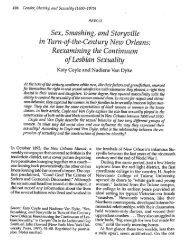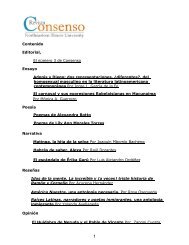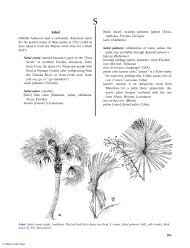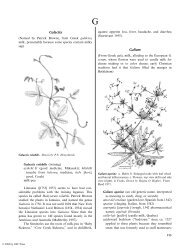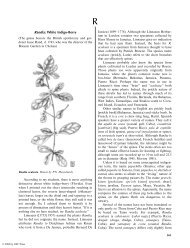Herba Cana - Northeastern Illinois University
Herba Cana - Northeastern Illinois University
Herba Cana - Northeastern Illinois University
Create successful ePaper yourself
Turn your PDF publications into a flip-book with our unique Google optimized e-Paper software.
© 2004 by CRC Press<br />
The Ethnobotany 549<br />
ceremonies, and other people also have names with<br />
reverent implications. Although the plants are not<br />
mentioned in the recent book on Haitian voodoo<br />
(Beauvoir et al. 2001), the names cabra blanca (white<br />
goat, Dominican Republic) and cabra santa (holy<br />
goat, Dominican Republic) suggest involvement with<br />
that religion. It is locally well known that the<br />
Santarías, a Cuban religious group related to voodoo<br />
(Voeks 1997), leave both goat and chicken offerings to<br />
their deities on the steps of the Miami-Dade County<br />
courthouse. So, cabra santa carries special meaning,<br />
and a cabra blanca is the best offering.<br />
The most information available about the religious<br />
and medical importance of P. nervosa is among the<br />
Huastec (Alcorn 1984). There the shrub is wats’ul, a<br />
simple name denoting great age. Wats’ul also has a<br />
number of alternate names, including tsakam wats’ul<br />
(little wats’ul, Veracruz) and wach’ul ch’ohool (wach’ul<br />
herb, Veracruz), perhaps denoting a taxonomy that<br />
does not match ours. The names baina ts’ohool (sheath<br />
herb, San Luis Potosí), itsal kw’a’ (toad chile, San Luis<br />
Potosí), and tse’tsem ts’ohool (woodpecker herb, San<br />
Luis Potosí) may also imply religious significance. The<br />
name tsabalte’ ts’ohool (skin fungus herb, San Luis<br />
Potosí) points to a medicinal use, and the names<br />
tse’tsem t’abat’ (little Tabernaemontana alba, San Luis<br />
Potosí), and tsakam tsabalte’ (little Cestrum dumetorum,<br />
San Luis Potosí) compare it with other plants<br />
important among those people. People in Belize say it<br />
is contra yierba (herb against), which is the description<br />
often given to a strong plant used to counteract<br />
poisons, or at least some problem from an outside<br />
source.<br />
The genus Psychotria was named by Linnaeus<br />
because of the reputed medical properties of some<br />
species. Which species he knew about being medicinal<br />
is more of a problem, as there are perhaps 1650 in the<br />
genus (Hamilton 1989a,b,c, Nepokroeff et al. 1999).<br />
However, discoveries in the late 1960s led to a renewed<br />
interest in Psychotria. Studies among people in the<br />
Amazon revealed that one or more members of the<br />
genus were added to the psychoactive plant mixture<br />
called ayahuasca (vine of the soul, Quechua), used for<br />
religious, medicinal, and social purposes (Pinkley<br />
1969, Schultes and Raffauf 1992). Subsequently,<br />
several studies of the genus have revealed alkaloids,<br />
benzoquinones, cyclic peptides, and other chemicals<br />
that exert a variety of influences on human physiology<br />
(e.g., Beretz et al. 1985, Adjibade et al. 1991, Amador<br />
et al. 2000, 2001, Khan et al. 2001, Verotta et al. 2002).<br />
None of the studies examined the Florida species, and<br />
the large genus is considered paraphyletic (Nepokroeff<br />
et al. 1999). Inferences of what might be the potential<br />
chemical bases for uses of P. nervosa or P. sulzneri are<br />
impossible, particularly because not all species contain<br />
the same classes of active compounds (Leal and<br />
Elisabetsky 1996).<br />
Still, the Huastec of Mexico use wats’ul as a love<br />
charm, and that is as good as any. You simply grind<br />
the seeds and carry them in a pocket. What could be<br />
easier?<br />
Ptelea<br />
(From ptao, to fly, the Greek name for the elm,<br />
reapplied by Linnaeus to this genus with a similar<br />
fruit; akin to Akkadian petelu, to wind, entwine)<br />
Ptelea trifoliata. From Sargent 1905.<br />
Ptelea trifoliata (three-leaved)<br />
ague bark (from the use to treat malaria)<br />
cola de zorillo (little skunk tail, Texas, Arizona,<br />
Sonora, Chihuahua, Tamaulipas, Veracruz);<br />
vara de zorro (fox bush, northern Mexico to<br />
Veracruz); zorillo (little skunk, Hidalgo; because<br />
plant and animals have a similar odor)<br />
dreiblättrige Lederbaum (three-leaf leather-tree,<br />
German, fide Millspaugh 1893); Lederstrauch<br />
(leather bush, German)<br />
[common, three-leaf, woolly] hop-tree [hoptree]<br />
(‘‘hop-tree’’ dates from ca. 1877, with the substitution<br />
of the fruits of Ptelea for those of hops,<br />
Humulus lupulus for making malt liquor, and as<br />
a tonic and soporific)<br />
orme de samaire à trois feuilles (samara elm with<br />
three leaves, French; fide Millspaugh 1892)<br />
pickaway[-anise]<br />
pinacatillo (comparing the smell with the pinacate<br />
beetle, Coahuila; from Náhuatl pinacatl, their<br />
name for the beetle Elodes spp., Tenebrionidae, a<br />
black insect that sprays an irritating, stinking<br />
chemical for defense)<br />
potato chip tree [potatochip-tree] (alluding to the<br />
flat fruits)<br />
prairie grub<br />
psehtin (Lakota)<br />
quinine-tree (a name comparing these shrubs with<br />
Cinchona spp., the source of the anti-malarial





